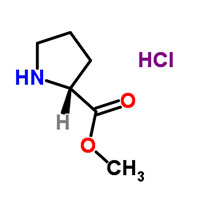D-proline methyl ester hydrochloride
Nanjing Finechem Holdings Co., LTD
Synonyms
Methyl (2S)-2-pyrrolidinecarboxylate hydrochloride
H-Pro-OMe.HCl
(S)-proline methyl ester hydrochloride
MFCD00083685
D-Proline, methyl ester, hydrochloride (1:1)
Methyl 2(S)-pyrrolidinecarboxylate HCl
Methyl D-prolinate hydrochloride (1:1)
L-Proline, methyl ester, hydrochloride (1:1)
Methyl L-prolinate hydrochloride (1:1)
methyl (2R)-pyrrolidine-2-carboxylate,hydrochloride
H-D-Pro-OMe.HCl
D-PROLINEMETHYLESTERHYDROCHLORIDESALT
Product Description
Introduction:
D-Proline Methyl Ester Hydrochloride is a chemical compound derived from D-proline, an amino acid widely
used in the pharmaceutical, cosmetic, and research industries. This product offers unique properties and
potential applications, making it valuable in various fields.
Raw Materials:
D-Proline Methyl Ester Hydrochloride is synthesized using high-quality raw materials, including
D-proline and methyl ester hydrochloride. D-proline is obtained through appropriate chemical reactions
or enzymatic methods, ensuring its purity and effectiveness. Methyl ester hydrochloride is obtained
through suitable chemical processes and subsequent purification steps to ensure the desired quality of
the final product.
Production Process:
The production of D-Proline Methyl Ester Hydrochloride involves carefully controlled steps to maintain
consistent product quality. D-proline is first obtained from the appropriate source and then reacted
with methyl ester hydrochloride under specific conditions. The reaction mixture undergoes purification
techniques such as filtration, crystallization, and drying, resulting in a white crystalline powder as
the final product.
Market Trends:
D-Proline Methyl Ester Hydrochloride has gained significant attention in the pharmaceutical and cosmetic
industries due to its potential applications. In the pharmaceutical sector, it serves as a vital
building block in the synthesis of peptides and pharmaceutical compounds. It finds applications in drug
discovery, peptide synthesis, and drug delivery systems. In the cosmetic industry, D-Proline Methyl
Ester Hydrochloride is used for its potential benefits in skin care formulations, anti-aging products,
and hair care treatments. The market demand for this product is driven by the increasing interest in
peptide-based therapeutics, personalized medicine, and advanced cosmetic formulations.
Amino Acid Status:
D-Proline Methyl Ester Hydrochloride offers unique advantages as an amino acid derivative. D-proline is
a cyclic amino acid that plays a crucial role in protein synthesis and structure. As a methyl ester,
D-Proline Methyl Ester Hydrochloride exhibits improved stability and solubility, enhancing its utility
in various applications. Its availability as a supplement allows for convenient incorporation into
formulations aimed at promoting skin health, peptide synthesis, and other research applications.
Conclusion:
D-Proline Methyl Ester Hydrochloride is a valuable chemical compound with diverse applications in the
pharmaceutical, cosmetic, and research industries. Its synthesis from high-quality raw materials and
stringent production processes ensure consistent product quality. The market demand for this product is
expected to continue growing due to its unique properties and potential applications in drug synthesis,
cosmetic formulations, and peptide-based therapeutics. With its various applications and potential
contributions to protein synthesis, peptide structure, and skin health, D-Proline Methyl Ester
Hydrochloride offers a valuable option for formulation and application in different industries,
providing a convenient means to support peptide synthesis, enhance cosmetic formulations, and advance
research endeavors.





